One of the ten new effect operators in the Korg opsix 2.0 firmware is Short delay. This effect, while technically correctly named, has many more uses than its name suggests, including some in physical modelling.
Block diagram
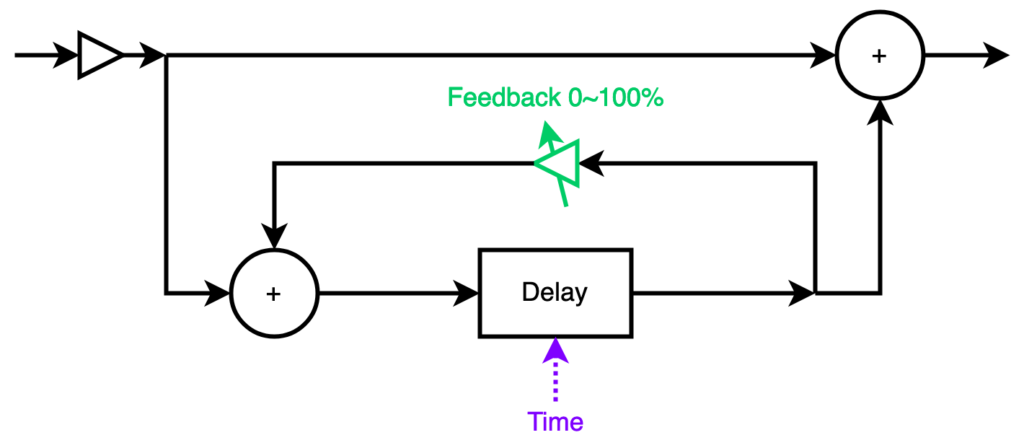
As its name suggests, Short delay adds a delayed copy of the signal back onto itself, producing a single echo up to 300 milliseconds later than the dry signal. As this delay is at most ⅓ of a second, it can produce only some of the delay effects that the standard Delay and BPM Delay postprocessing effects can.
Echoes
One immediately apparent use of Short delay is to simulate the early reflections of a reverberation effect. Early reflections are sometimes used deliberately to produce a gated percussion sound. While the opsix has a built-in Early reflections effect, it applies to the entire signal; by using Short delay operators, you can build a sound where only some of the components have a reflection.
The following sample is a split-keyboard drum kit. Below the split, operator 5 is a kick drum. Above, operator 6 is a snare drum. (Incidentally, both drums themselves use different effect operators from the 2.0 firmware to enhance their sound.) Operators 1 to 4 are all Short delays, with different amounts of delay from 70 ms to 150 ms. The spread of delay times produces the characteristic scatter common to early reflections. It is possible to customize the envelope of the reflection by adjusting the volume sliders of operators 1 to 4.
Feedback
The Short delay effect operator also includes a Feedback control (modification knob F). Feedback adds a decaying echo to the signal, and while this can be used for stereotypical bottom-of-the-canyon echoes, there are other uses. Whereas a 100% feedback on a traditional delay effect will quickly end in a mush of never-ending sound, high feedback levels in a Short delay operator are fine, because the operator output is shaped through the operator envelope, so the feedback will end after the key is released and the release stage of the envelope completes. A 100%-feedback Short delay operator becomes a kind of low-frequency oscillator (LFO).
The following sample uses feedback to create something of a dulcimer hammer feel. Once the note is released, the repetition stops.
Short delay as a flanger
When an LFO becomes so rapid that it enters audio range, the character of a sound changes. This concept is familiar to any user of frequency modulation (FM) synthesis. A similar thing happens with the Short delay effect operator: when the delay is shortened to, say, 10 ms, frequencies in the signal with a period of twice this delay (i.e., 50 Hz) undergo destructive interference and are cancelled. The same thing happens at frequencies of 150 Hz, 250 Hz, and so on, up to infinity. This happens even if the Feedback control is set to zero!
You may recognize this as the description of the classic flanger effect, and you would be right. A flanger effect differs from a phaser effect in that phasers have a finite number of cancelled frequencies, and those frequencies are usually deliberately chosen to be harmonically unrelated. With a flanger, the notch frequencies are harmonically related, and there are an infinite number of them, all the way to the sampling limit of the instrument.
With a flanger, the Feedback modification knob does not affect the cancelled frequency notches; rather, it enhances the passed frequencies in a way similar to filter resonance.
The following sample is precisely the same patch as the dulcimer sample above, but with the delay shortened to a few milliseconds. The resulting timbre is noticeably different, and because the Short delay operator does not do key tracking like the Phaser operator does, different pitches of note have different timbres.
As discussed in the previous post about the Phaser effect, postprocessing flanger effects typically have their delays (and thus frequency notches) modulated with an LFO. This is easily done in the Short delay operator with a V.Patch using an LFO as input.
The opsix also has a standard Flanger post-processing effect, and like the Phaser effect, it is stereo, can be tied to the tempo of the music being played, and can have its wet/dry ratio easily controlled.
Short delay as a comb filter
You may also recognize the block diagram of Short delay as being the same as a feed-forward comb filter, and you would also be right, because a flanger is a kind of comb filter. So named because the frequency response on a linear-frequency amplitude response graph looks like the regular teeth of a comb, comb filters are common in physical modelling.

One of the more well-known physical-modelling uses of a comb filter delay is in the Karplus-Strong model of a plucked string. In this model, the string is given an initial excitation (the “pluck”), and then it is allowed to freely vibrate, with the excitation propagating along the string and reflecting off the tied-down ends. This travel time and reflection can be modelled with a short delay. Inevitable losses in the reflection are modelled with a low-pass filter that chips away at higher frequencies, one bounce at a time.
The pluck (excitation) of a Karplus-Strong string is ideally a short broad-spectrum burst of noise. In practice, the pluck should be low-pass-filtered a bit. The opsix 2.0 Pink noise waveform is a pretty good starting point. Some extra low frequency boost doesn’t hurt; this can be accommodated by making the pluck operator use a Drive, Distortion or Punch effect. The duration of the pluck should be about one cycle length, 10 ms or less. An ADSR envelope with very short attack and decay, and zero sustain, will do. In practice, the exact nature of the pluck doesn’t have a huge impact on the tone of the string. The sound is carried by the feedback loop of delay and filter, long after the pluck has stopped touching the string. The flanger-like notches in the comb filter delay ensure that only the note with the period matching the propagation delay and its harmonics remain after a few trips around the feedback loop.
The string propagation delay and the low-pass loss filter in the Karplus-Strong model can be respectively be represented in the opsix as a Short delay effect operator and a Filter operator (this is one of the five operator types present in firmware version 1.0). It is easiest to join the three operators correctly with a user algorithm.
The following sample is a Karplus-Strong string algorithm built with three opsix operators. It sounds a bit out of tune because, well, it is. A shortcoming of the opsix Short delay operator is that the delay is measured in milliseconds, and not in hertz. Without keyboard tracking, every note on the keyboard produces the same pitch of plucked string. Some degree of keyboard tracking can be applied with a V.Patch that modulates the delay time using the note number, but as the relationship between a note’s period and its frequency is nonlinear, it isn’t possible to make this work well over more than an octave. For a bass line, it might just sound OK, but it’s not exactly equal temperament.
Conclusion
With all of the different things that the Short delay effect operator can do, it’s no wonder that the effect’s name feels like a poor fit. While the echo and flanger uses are clearly advantageous, the lack of keyboard tracking for the delay time feels like a missed opportunity, preventing true physical modelling of plucked strings. This unfinished business I will address when I cover the next effect, the Comb filter effect operator.
Part 1: Phaser | Part 2: Short delay | Part 3: Comb filter
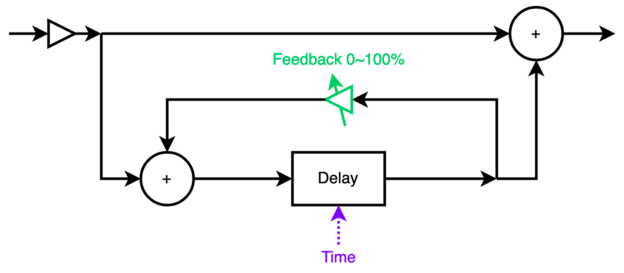

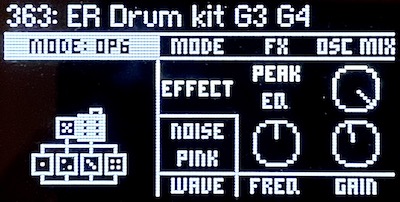
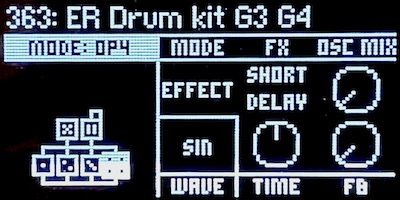
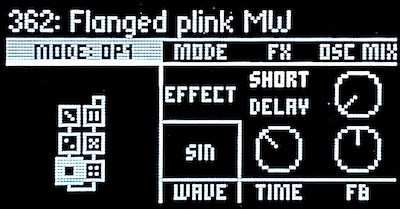
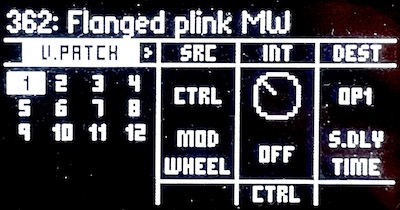
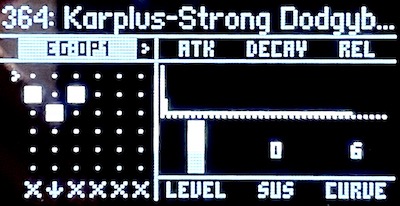
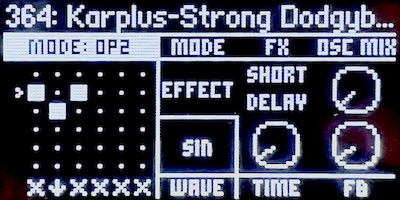
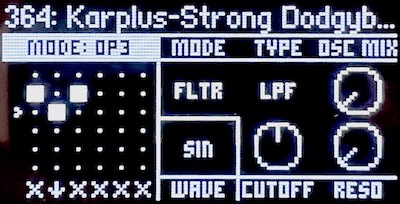
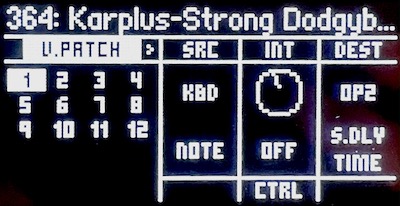
Leave a Reply